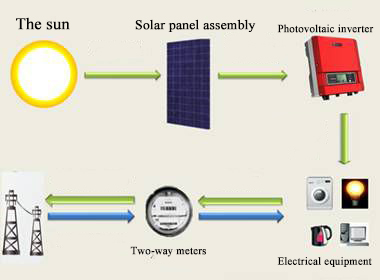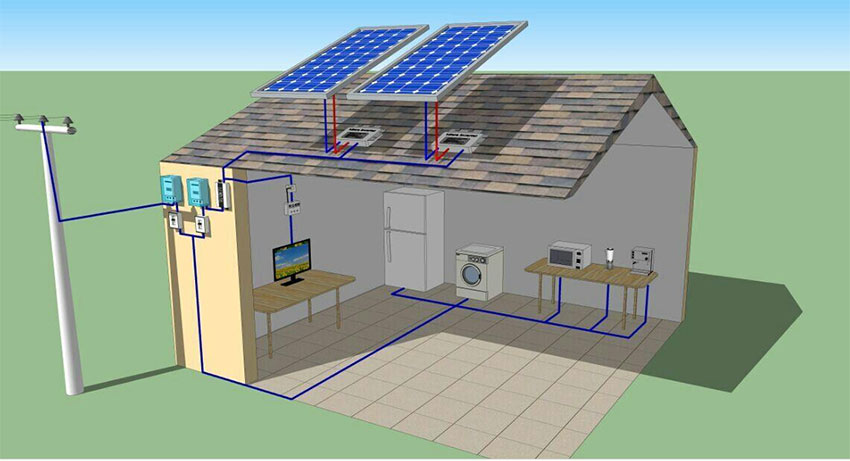How to build a home solar power system
Want to install a system that can generate electricity is very simple, the main need five things:
1.Solar panel
2. Solar Mounting System
3. Cables
4. Solar inverter
5. The grid company is responsible for the installation of the meter (Meter)
Here to explain the photovoltaic inverter: electricity generated by solar panels is a direct current, home appliances can not be used directly, must be converted into AC power through the inverter can be home.
Next, you need to consider the system design, as the home system installed capacity (MaximumInput) is generally about 1-5 kilowatts, the system design and installation are very simple, the inverter is based on installed capacity corresponding to choose 1-5 kilowatts specifications of the machine can.
Take a 5KW home system as an example:
1. Solar panels (components) of the choice
Currently on the market of solar cells are divided into amorphous silicon and crystalline silicon. Among them, crystalline silicon can be divided into polycrystalline silicon and single crystal silicon. From the three kinds of materials, the photoelectric conversion efficiency is: monocrystalline silicon (up to 17%)> polycrystalline silicon (12 ~ 15%)> amorphous silicon (about 5%). Crystalline silicon (single crystal silicon and polycrystalline silicon) in the weak light is basically no current, amorphous silicon weak light (good energy in low light is very small). Therefore, a comprehensive view, it is appropriate to use monocrystalline silicon or polycrystalline silicon solar cell materials, but also consider the high cost of monocrystalline silicon materials, so the general selection of polysilicon materials. If you choose a polycrystalline silicon solar panel with a power of about 250W, then a 5KW system will require 20 panels.
2 stent selection
Solar PV bracket is a special bracket in the solar photovoltaic power generation system for placing, installing and fixing the solar panel design. General materials are aluminum, stainless steel, after hot galvanized processing longer life. Bracket is divided into two main categories: fixed and automatic tracking. Currently, some fixed brackets on the market can also make some adjustments according to the seasonal changes of the sun's rays. Just as when they were installed, the incline of each solar panel can be adjusted by moving the fasteners and adjusting the incline to the light Different angles, through the re-fastening of the solar panels accurately fixed in the designated location. Auto-tracking solar powered brackets have a rotating mechanism that adjusts the angle of rotation as the sunflower itself, with high utilization of light energy, but at a relatively high cost. In China, the solar panels are generally installed in the south, the user can choose to use a fixed bracket, such as the cost of sunflowers automatically track the sun bracket is a good choice.
3. Cable selection
As mentioned above, the inverter converts the DC power generated by the solar panels into AC power. We then call the DC side of the inverter from the DC side (DC side) and the DC side needs to be used Photovoltaic dedicated DC cable (DC cable). Also for PV applications, solar systems are often used under harsh environmental conditions such as intense UV, ozone, severe temperature changes and chemical attack. This stipulates that PV cables must have the best weather, UV and ozone resistance, as well as being able to withstand a wider range of temperature changes. It is therefore recommended to use a dedicated solar power cable, which will affect the life of the entire system. A 5KW system is typically 4mm2 or 6mm2 for a PV DC cable.

4. The choice of inverter
Consider first the orientation of the solar panels. If the layout of components is inconsistent, for example, the interior of the country is always south facing, but it can be divided into southwest or southeast. If it is arranged in both directions at the same time, it is recommended to use dual MPPT to track inverter Dual-mppt, for the moment being understood as a dual-core processor, handles the calculation of one direction for each core. Then according to the installed capacity of the inverter to choose the same specifications on it. A 5KW system has the option of using a 5KW dual MPPT tracking inverter. The GDCW inverter has a 5KW dual MPPT tracking inverter that is ideal for use on this domestic rooftop solar system. In addition, GOLDMY also developed and produced 1-4.6KW single-phase single-channel, 3.6-4.6 single-phase dual-channel, 4-6KW small three-phase dual and 10-30KW three-phase dual inverter Meet different sizes of domestic rooftop solar power system.
5. The grid company is responsible for the installation of the meter (two-way meter)
Two-way metering meter is able to measure electricity and power meter. Power and energy are directional, from the point of view of electricity, electricity is considered as positive power or positive energy, power generation is considered as negative power or negative energy, the meter can read through the display were positive and Reverses the charge and stores the charge data. The reason for installing bi-directional ammeter is that the photovoltaic power can not be totally consumed by the user, while the remaining power needs to be lost to the grid. The meter needs to measure a number. When the photovoltaic power generation can not meet the demand, it needs to use the power of the grid, This, in turn, requires measuring another number, which can not be achieved by an ordinary monolithic meter, so a smart meter with bi-directional meter metering is used.
After the purchase, due to the simple design of home wiring and system, ordinary users only need to find a qualified electrician to solve the wiring problems in the home. The bracket maintains a 45 degree angle (if you do not consider the cost, you can choose Sunflower to automatically track the sun bracket) The connection as long as the reference manual on the line.
If your home has its own garden swimming pool or high-tech farm what you can choose a 10-20KW home system, usually 20KW system requires about 80 250W solar panels, connected to a 20KW three-phase dual inverter , At this time the inverter connection will be relatively more complex, you need to find a professional system integrator, considering the wiring, with the inverter port, weather and other factors to design and complete the construction.















